Trogir emerges as a living testament to a storied past that unfolds with each stride through its ancient thoroughfares. With a history spanning over two millennia, this UNESCO World Heritage Site weaves together a compelling narrative of architectural wonders, medieval allure, and tales echoing through the corridors of time.
From its genesis as a Hellenic settlement to its zenith during the epochs of Roman and Venetian rule, Trogir’s historical tableau invites exploration, unveiling stories of conquests, trade, and artistic brilliance. Embark on a journey through Trogir’s intriguing chronicles, where every cobblestone pathway harbors a fragment of the town’s mesmerizing past waiting to be unveiled.
Trogir’s History Through Time
- Trogir's History Through Time
- 1. Venetian Influence
- 2. Ottoman Threats
- 3. Napoleonic Era and Austrian Rule
- 4. Modern Era
- 5. Trogir Flourishing Under Roman Influence in Ancient Times
- 6. Trogir in the Medieval Tapestry: A Flourishing Haven of Culture and Commerce
- 7. Trogir Amidst Ottoman Shadows: A Town's Resilience in the Ottoman Era
- 8. Trogir Embraces the Serenity of Venetian Rule: A Flourishing Town in the Venetian Era
Trogir, a UNESCO World Heritage Site on Croatia’s Dalmatian Coast, has a storied history that unfolds like a captivating narrative, revealing layers of influence from ancient civilizations to medieval powers. Its strategic location at the crossroads of major trade routes and its architectural splendors make Trogir a living testament to the cultural richness of the Adriatic region.
I. Ancient Origins
The roots of Trogir date back to ancient times, with the establishment of a Greek settlement known as Tragurion in the 3rd century BC. Romans later recognised its strategic importance, and the town flourished under their rule, adopting the name Tragurium. During the Roman era, Trogir evolved into a bustling center for trade and craftsmanship, leaving behind archaeological remnants such as the well-preserved city walls.
II. Medieval Era
The medieval period saw Trogir become part of the Byzantine Empire and, later, the Kingdom of Croatia. The town’s fortunes became closely tied to the rise of the Croatian-Hungarian Kingdom and, subsequently, the Republic of Venice. The Venetian influence is particularly evident in Trogir’s architecture, fortifications, and layout, showcasing the town’s role as a key maritime hub.
In the 13th century, Trogir gained prominence under the rule of the Šubić family. The Cathedral of St. Lawrence, a masterpiece of medieval architecture, was constructed during this time. Its intricate carvings, including the Radovan Portal, are considered among the finest examples of Croatian medieval art.
1. Venetian Influence
Trogir’s destiny became intertwined with the Venetian Republic, which left an indelible mark on the town’s appearance. The Venetians fortified Trogir to protect against Ottoman invasions, adding structures like the Kamerlengo Fortress and St. Mark’s Fortress. This period of Venetian rule also contributed to the unique blend of architectural styles, ranging from Romanesque and Gothic to Renaissance and Baroque, that defines Trogir’s Old Town.
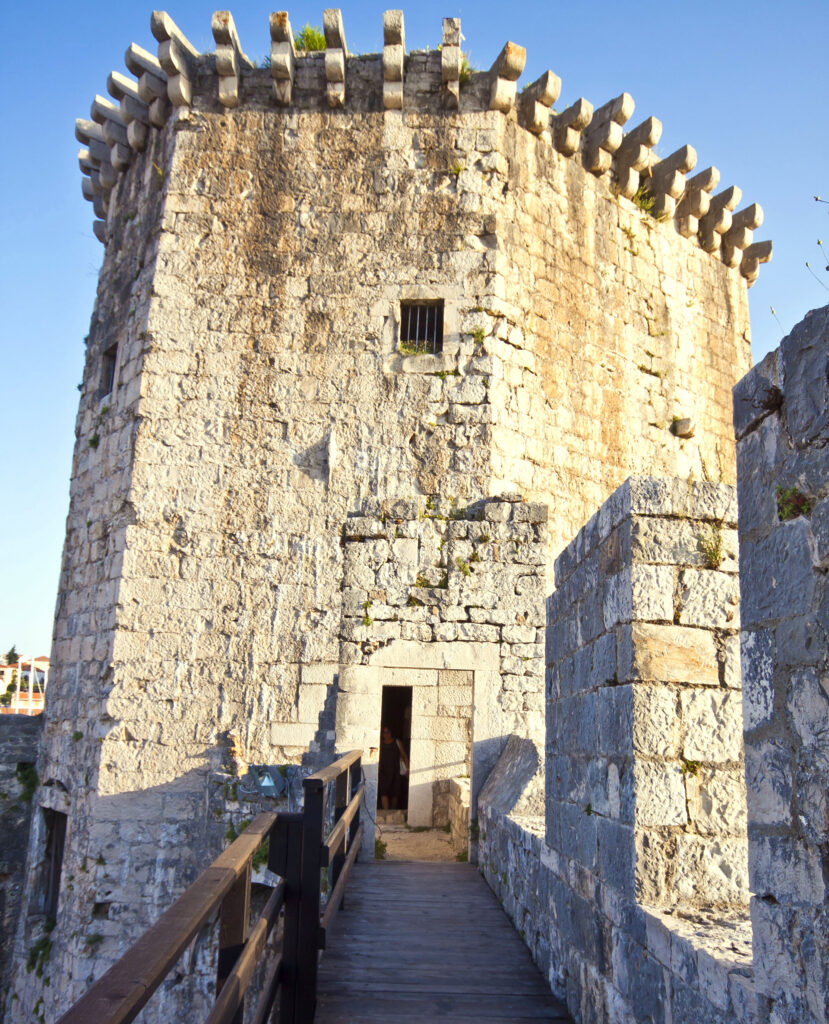
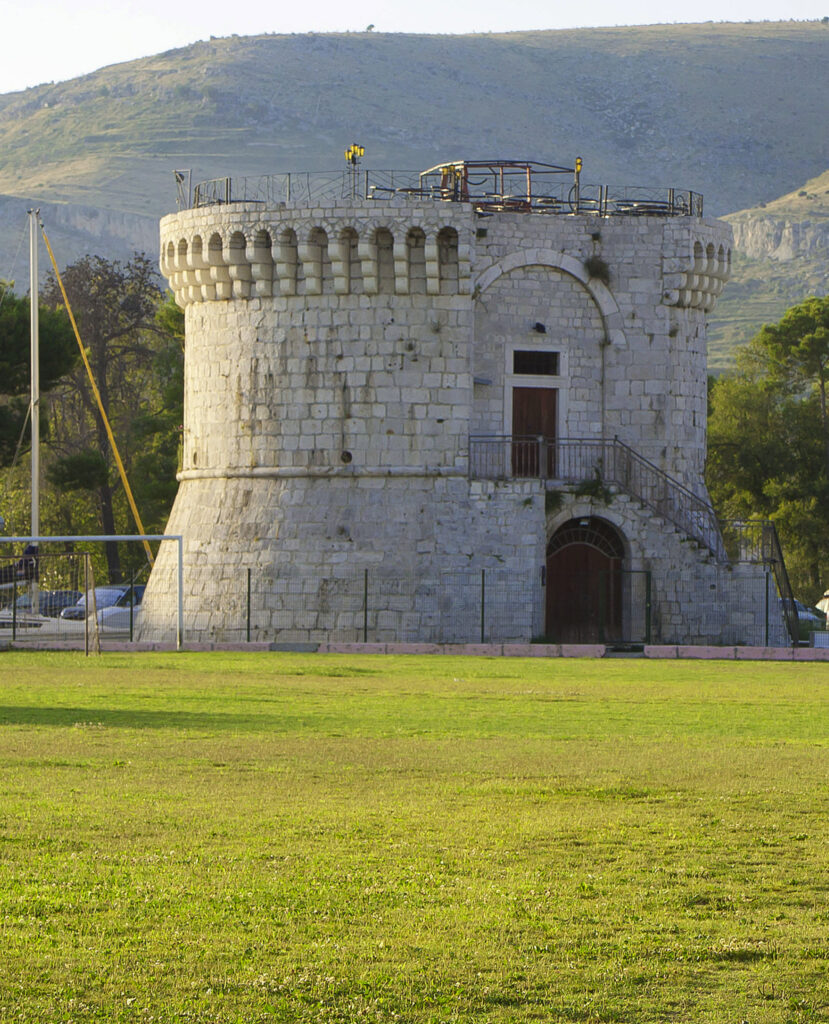
The Kamerlengo Fortress, a formidable medieval structure situated in the heart of Trogir, stands as a testament to the town’s rich history and strategic importance. Built in the 15th century by the Venetians, the fortress served as a defensive bastion against potential invaders, overlooking the Adriatic Sea with an imposing presence.
Characterized by robust stone walls and commanding towers, Kamerlengo offers panoramic views of the town, its surroundings, and the shimmering coastline. The fortress, with its well-preserved architecture, includes a central courtyard, vaulted chambers, and a tower that once housed the ruling authorities.
Visitors can explore the labyrinthine passages, climb to the top of the towers for breathtaking vistas, and imagine the historical events that unfolded within its walls. Kamerlengo Fortress stands not only as a symbol of Trogir’s resilience but also as a captivating site for those seeking to delve into the medieval legacy of this charming Croatian town.
2. Ottoman Threats
Trogir faced challenges from the Ottoman Empire in the 16th century, leading to the strengthening of its defenses. The town successfully repelled Ottoman attacks, preserving its autonomy and cultural heritage. The legacy of these defensive measures can still be explored in the form of fortifications and towers that dot the town’s landscape.
Trogir, as a historic Croatian town, predominantly showcases architectural influences from various periods, including Romanesque, Gothic, Renaissance, and Baroque styles. The Ottoman Empire, historically, did not have a significant presence in Trogir or the broader Dalmatian region.
The town’s architecture is more closely associated with the Venetian Republic, which had considerable influence in the Adriatic during different periods. The Kamerlengo Fortress and St. Mark’s Tower, for example, reflect the Venetian architectural style that characterized Trogir in the 15th and 16th centuries.
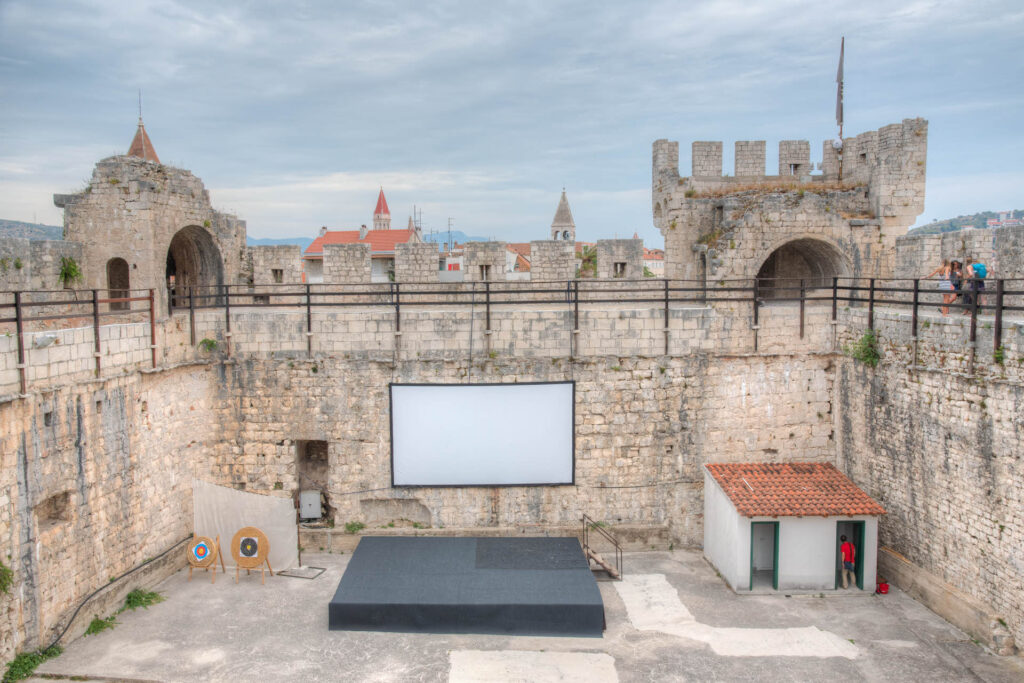
3. Napoleonic Era and Austrian Rule
In the early 19th century, Trogir witnessed changes during the Napoleonic era, eventually falling under Austrian rule. The town continued to adapt to new geopolitical circumstances while retaining its historical character.
4. Modern Era
Trogir’s historical significance and architectural treasures were recognized when it was designated a UNESCO World Heritage Site in 1997. Today, visitors can wander through its labyrinthine streets, marvel at centuries-old structures, and immerse themselves in the vibrant history that unfolds at every turn.
Trogir’s journey through time encapsulates the ebb and flow of civilizations, from ancient Greek foundations to Roman prosperity, Venetian dominance, and resilience against Ottoman threats. Each cobblestone street and weathered stone in Trogir narrates a tale of survival, adaptation, and the enduring spirit of a town that has stood witness to the changing tides of history on the sun-kissed shores of the Adriatic.
5. Trogir Flourishing Under Roman Influence in Ancient Times
In the annals of Trogir’s history, the era of Tragurium (ancient name of Trogir) during Roman times stands as a testament to the town’s early prosperity and significance in the Adriatic region. Tracing its origins to the 3rd century BC, Tragurium, as it was known in antiquity, became a thriving settlement under the influence of the Roman Empire, leaving an indelible mark on the town’s landscape and shaping its trajectory for centuries to come.
Strategic Location and Roman Influence: Situated strategically on the Dalmatian Coast, Tragurium benefited from its prime location along important trade routes, becoming a hub for commerce and cultural exchange. The Romans, known for their strategic vision and penchant for harnessing the economic potential of key locations, recognized the value of Tragurium as a coastal town with access to the Adriatic Sea.
Under Roman rule, Tragurium underwent significant urban development. The Romans erected structures, laid out streets, and established public spaces that reflected their architectural prowess and organizational acumen. Traces of this Roman influence can still be glimpsed in the remnants of city walls and archaeological discoveries within Trogir’s Old Town.
Commerce and Craftsmanship: As a vital center for trade, Tragurium became a bustling marketplace where goods from across the Roman Empire and beyond exchanged hands. The town’s prosperity was fueled not only by its coastal location but also by the skilled craftsmanship of its inhabitants. Artisans and traders plied their trades, contributing to the town’s economic vibrancy and cultural diversity.
Architectural Legacy: The Romans, known for their engineering marvels, left an enduring architectural legacy in Tragurium. The remnants of Roman structures, including parts of city walls and gates, bear witness to the meticulous craftsmanship of the time. The integration of Roman design principles laid the groundwork for the later evolution of Trogir’s architectural styles under subsequent rulers.
Cultural Synthesis: Tragurium was not merely a Roman enclave but a melting pot where diverse cultures converged. The town became a microcosm of the broader Roman Empire, blending indigenous Illyrian influences with Roman traditions. This cultural synthesis, evident in aspects of daily life, from language to customs, contributed to the unique identity of Tragurium.
Enduring Foundations: While the specific details of daily life in Tragurium during the Roman era may be obscured by the sands of time, the enduring foundations laid by the Romans played a pivotal role in shaping the town’s destiny. The infrastructure, economic vitality, and cultural amalgamation fostered during this period formed the groundwork upon which Trogir would later thrive.
The echoes of Tragurium’s Roman past reverberate through the cobbled streets and ancient walls of Trogir, offering glimpses into an era when this coastal gem first began to sparkle under the sun, poised at the crossroads of history, commerce, and cultural exchange in the heart of the Adriatic.
6. Trogir in the Medieval Tapestry: A Flourishing Haven of Culture and Commerce
As the pages of history turned, Tragurium gracefully transitioned from the embrace of the Roman Empire to the medieval era, a period marked by shifting powers, dynamic cultural exchange, and the indomitable spirit of adaptation. In the medieval tapestry of Trogir’s history, Tragurium emerged as a flourishing haven, weaving together the threads of commerce, art, and resilient fortifications.
Byzantine and Croatian Influences: The medieval era witnessed the Byzantine Empire leaving its imprint on the Dalmatian region, and Tragurium was no exception. In the early medieval period, Trogir experienced the interplay of Byzantine and Croatian influences, reflecting the complex geopolitical dynamics of the time. The town found itself part of the Croatian-Hungarian Kingdom, becoming a focal point for trade and cultural exchange.
The Šubić Family and Prosperity: In the 13th century, Trogir, including the former Tragurium, experienced a significant chapter under the rule of the Šubić family. This noble Croatian family played a pivotal role in the town’s prosperity, contributing to its cultural and economic growth. The Šubićs, recognizing the strategic importance of Trogir, nurtured an environment conducive to trade, craftsmanship, and artistic endeavors.
Cathedral of St. Lawrence (St. Lovro): One of the crowning achievements of this period was the construction of the Cathedral of St. Lawrence. A masterpiece of medieval architecture, the cathedral bears witness to the town’s thriving artistic and cultural scene. The Radovan Portal, carved by the master craftsman Radovan in the 13th century, is an exquisite example of medieval sculpture and a testament to the town’s flourishing artistic community.
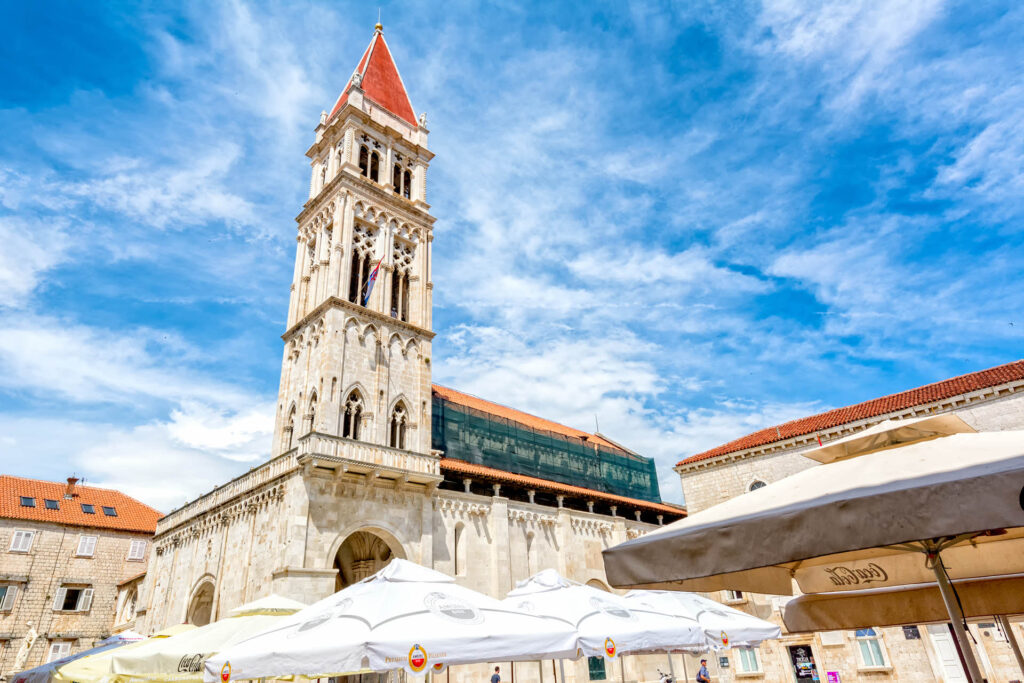
Venetian Influence and Maritime Strength: The medieval period saw Trogir come under the sway of the powerful Republic of Venice. Venetian influence left an enduring mark on the town’s architecture, fortifications, and maritime prowess. Recognizing the strategic importance of Trogir’s coastal location, the Venetians fortified the town against potential threats, adding structures such as the Kamerlengo Fortress and St. Mark’s Fortress.
Ottoman Threats and Fortifications: The later medieval era brought with it the looming threat of the Ottoman Empire. Trogir, like many coastal towns in the region, faced the challenges of defending against Ottoman invasions. The town responded by fortifying its defenses, constructing walls, towers, and fortresses to safeguard its inhabitants from the impending Ottoman threat. The legacy of these fortifications can still be explored in Trogir’s Old Town.
Cultural Renaissance: Amid the strategic concerns and defensive measures, Trogir experienced a cultural renaissance during the medieval era. The town’s streets bustled with the activity of traders, artists, and scholars, creating an atmosphere of cultural vibrancy. Trogir’s role as a maritime and trade hub facilitated the exchange of ideas, artistic expressions, and craftsmanship, fostering a rich cultural tapestry.
Legacy and UNESCO Recognition: Trogir’s medieval legacy, marked by architectural marvels, maritime strength, and cultural richness, was acknowledged when the town was inscribed as a UNESCO World Heritage Site in 1997. The medieval spirit, alive in the narrow alleys, stone facades, and imposing fortifications, continues to captivate visitors, inviting them to step back in time and relive the medieval chapter of Tragurium’s enduring history.
7. Trogir Amidst Ottoman Shadows: A Town’s Resilience in the Ottoman Era
As the Ottoman Empire cast its formidable shadow across the Balkans, Tragurium—known in its contemporary form as Trogir—faced a pivotal period of challenge and fortitude. The Ottoman era brought about a complex interplay of cultural, economic, and defensive dynamics, shaping Trogir’s narrative and leaving an indelible mark on the town’s character.

Ottoman Threats and Defensive Measures: The Ottoman advance into the Balkans during the 15th and 16th centuries posed a significant threat to coastal towns, including Trogir. Recognizing the imminent danger, the town implemented rigorous defensive measures to withstand potential Ottoman incursions. Walls were fortified, towers were erected, and the Kamerlengo Fortress assumed a crucial role in Trogir’s defense strategy.
Fortifications and Architecture: Trogir’s medieval walls, designed to withstand the evolving challenges of warfare, took on added significance during the Ottoman era. The town’s fortifications, including the Kamerlengo Fortress overlooking the Adriatic, were reinforced to create formidable barriers against potential invaders. These structures, testaments to Trogir’s strategic foresight and determination, still stand today, offering a glimpse into the town’s defensive prowess.
Cultural Exchange and Challenges: While the Ottoman era brought military threats, it also ushered in a period of cultural exchange. Trogir, situated at the crossroads of diverse influences, found itself at the confluence of Ottoman, Venetian, and Croatian cultures. The town became a melting pot where different traditions converged, contributing to Trogir’s unique identity.
Commerce and Maritime Resilience: Despite the challenges posed by the Ottoman Empire, Trogir maintained its maritime and commercial significance. The Adriatic Sea continued to be a vital conduit for trade, and Trogir’s maritime resilience allowed it to navigate the complexities of Ottoman dominance. The town’s strategic location on the Dalmatian Coast ensured its continued role as a hub for maritime commerce.
Trogir’s ability to adapt to changing geopolitical landscapes became evident during the Ottoman era. While fortified walls and defensive structures safeguarded the town, Trogir also embraced economic endeavors that allowed it to thrive amidst the challenges. The town’s resilience during this period laid the foundation for its continued prominence in the Adriatic region.
Legacy and Preservation: The architectural legacy of the Ottoman era, entwined with Trogir’s medieval and Venetian influences, contributes to the town’s allure. Visitors wandering through the cobblestone streets encounter structures that bear witness to Trogir’s complex history of adaptation and resilience in the face of Ottoman dominance.
8. Trogir Embraces the Serenity of Venetian Rule: A Flourishing Town in the Venetian Era
In the annals of Trogir’s history, the Venetian era stands as a testament to a period of prosperity, cultural refinement, and architectural splendor. Tragurium, evolving into Trogir, found itself under the sway of the powerful Republic of Venice, ushering in an age of Venetian influence that would profoundly shape the town’s character and leave an indelible mark on its architectural landscape.
Venetian Dominion and Maritime Supremacy: During the late medieval period and into the Renaissance, Trogir fell under the dominion of the Republic of Venice. This marked a transformative chapter for the town, as Venetian influence became a defining element of its cultural and architectural identity. Venice, a maritime power of unparalleled influence, brought with it not only political control but also a commitment to enhancing Trogir’s strategic importance in the Adriatic.
Architectural Flourish: The Venetian Republic, renowned for its architectural prowess, left an enduring imprint on Trogir’s skyline. The town’s urban fabric saw the emergence of Venetian-style palaces, elegant public buildings, and squares that reflected the grace and sophistication of Renaissance architecture. The legacy of this period is most evident in the intricate details of Trogir’s Old Town, where Romanesque, Gothic, and Renaissance elements harmoniously coalesce.
Fortifications and Defensive Works: Venice’s strategic approach to fortifications became instrumental in Trogir’s defense against external threats, particularly from the Ottoman Empire. The Kamerlengo Fortress, overlooking the Adriatic, became a symbol of Venetian military prowess and a key component of Trogir’s defensive strategy. Additionally, St. Mark’s Fortress, strategically positioned to guard the town’s southern approach, further solidified Trogir’s readiness against potential adversaries.
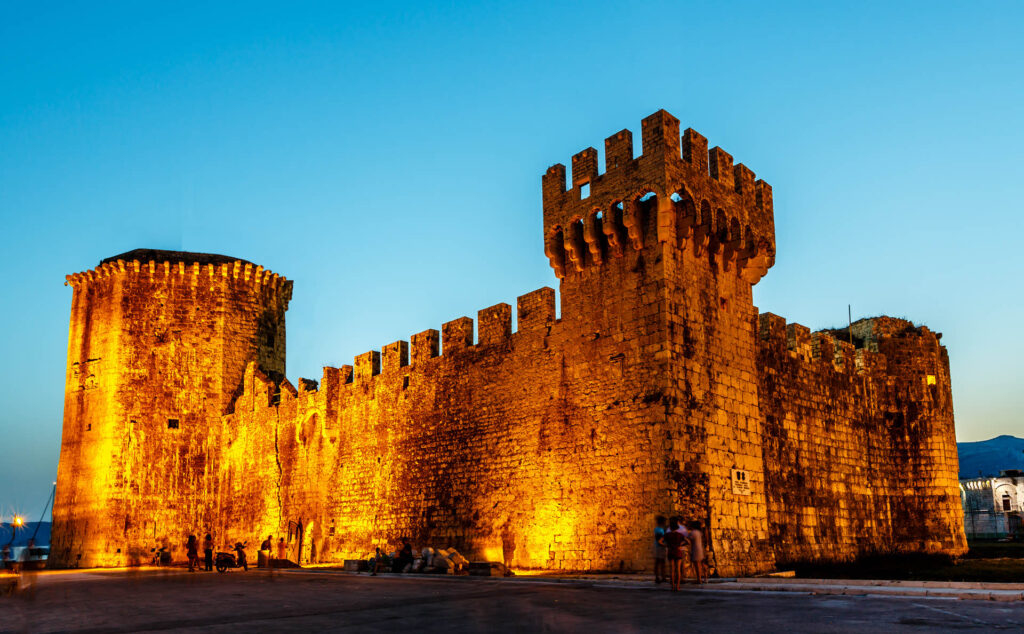
Economic Prosperity and Trade: Under Venetian rule, Trogir experienced economic prosperity driven by maritime trade. The Venetians recognized the strategic significance of Trogir’s location on the Dalmatian Coast and its role as a hub for trade in the Adriatic. The town’s bustling markets, thriving artisan workshops, and maritime activities contributed to its reputation as a flourishing center of commerce and culture.
Cultural Exchange and Influences: Venice’s cosmopolitan ethos infused Trogir with a rich tapestry of cultural influences. The town became a melting pot where Venetian, Dalmatian, and Mediterranean traditions converged. This cultural exchange is reflected not only in the architectural elements but also in the town’s social and artistic life.







